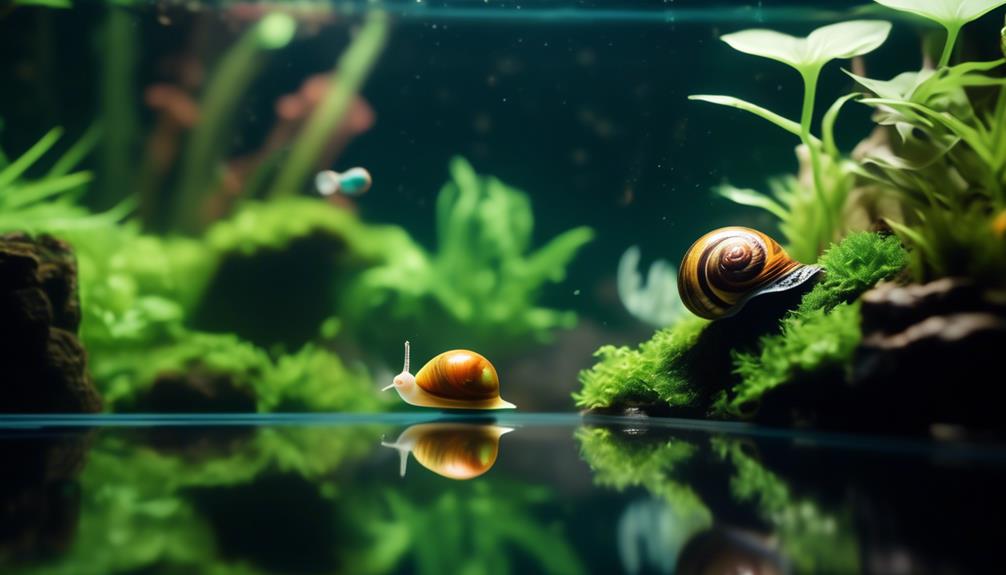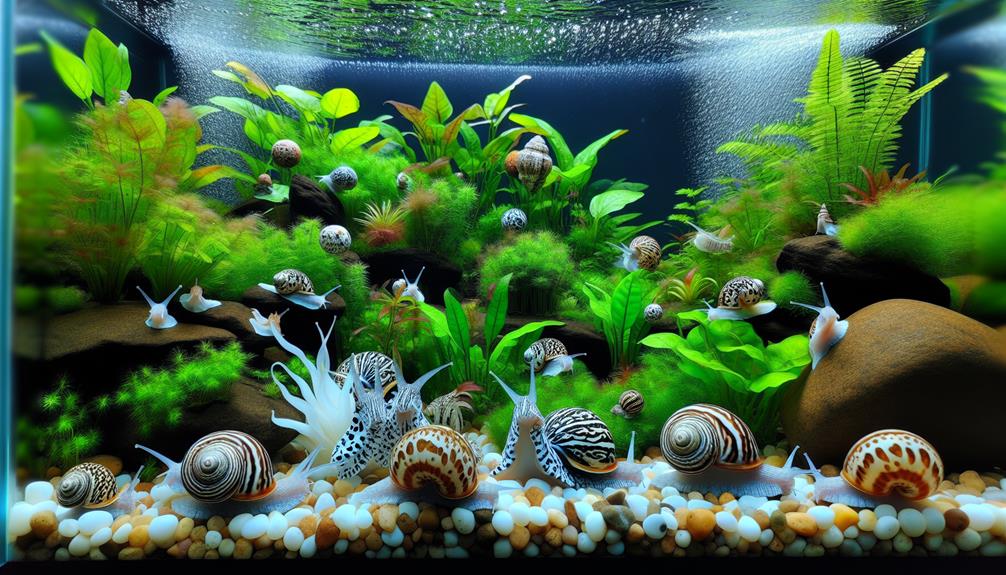Looking to add some intrigue and functionality to your freshwater aquarium? Prepare to be amazed by the ultimate snail squad!
These seemingly unassuming creatures possess a unique combination of charm and practicality, making them the ideal addition to any aquatic community. From their ability to control algae growth to their knack for maintaining the cleanliness of your tank, these snails are the unsung heroes of the underwater world.
But which snail species should you choose? Well, the answer lies within the pages of this article, where you will discover the top snails that will revolutionize your aquarium experience.
So, without further ado, let's embark on a journey to unravel the secrets of the ultimate snail squad for your freshwater aquarium.
Key Takeaways
- Snails prefer higher pH and GH levels for proper shell development.
- Provide mineral supplements and calcium-rich foods to support snail health and shell integrity.
- Different snail species have different care requirements, such as temperature and pH tolerance.
- Controlling snail populations can be achieved by managing algae growth, removing excess organics, and controlling overfeeding.
General Care Tips for Snails
Snails in freshwater aquariums require specific care to ensure their well-being and proper shell development. When it comes to snail breeding techniques, it's important to create and maintain optimal water conditions.
Firstly, snails prefer a higher pH above 7.0 and higher GH above 8° (140 ppm) for proper shell development. If you notice shell damage, consider dosing the water with mineral supplements like Wonder Shell and Seachem Equilibrium. Additionally, crushed coral in the substrate and filter media can help buffer up the pH.
In terms of feeding, it's crucial to provide calcium-rich foods such as Shrimp Cuisine, Crab Cuisine, and Zoo Med Nano Banquet Food Blocks to support their shell growth.
Lastly, snails are sensitive to salt, so it's advised to remove them from the aquarium before treating fish with sodium chloride.
Bladder Snail
The Bladder Snail, a member of the Physidae family, features a brown, bulbous shell with speckled spots. These snails stay small, measuring less than 1 inch (2.5 cm), making them suitable for cleaning out nooks and crannies in the aquarium.
They can tolerate a wide range of pH and temperatures, making them adaptable to various freshwater environments. While having bladder snails in your aquarium can be beneficial, their population can quickly explode if not managed properly. This may indicate overfeeding or excessive algae growth, so it's important to control these factors.
To control the bladder snail population, you can manually remove them or introduce natural predators like assassin snails. Despite their rapid breeding, bladder snails can help maintain a balanced ecosystem by consuming excess organics and algae in the tank.
Nerite Snail

Nerite snails, belonging to the Neritidae family, are highly efficient algae eaters commonly found in freshwater aquariums. These snails range in size from 0.5 to 1.5 inches (1.3 to 3.8 cm) and are available in various varieties. However, they're prone to escaping, so it's important to keep a tight lid on the aquarium.
In terms of diet, Nerite snails can be supplemented with canned green beans, blanched zucchini slices, and Zoo Med Nano Banquet Food Blocks.
When it comes to shell care, Nerite snails prefer a higher pH above 7.0 and a higher GH above 8° (140 ppm) for proper shell development. If shell damage is noticed, dosing the water with mineral supplements like Wonder Shell and Seachem Equilibrium can be beneficial.
Ramshorn Snail
Ramshorn snails, members of the Planorbidae family, possess a distinctive shell that resembles the coiled horn of a ram. These snails can grow up to 1-2 inches (2.5-5 cm) and come in various shell color variations, including red, brown, and even blue.
Ramshorn snails are excellent cleaners for the aquarium as they consume algae, fish food, and decaying plant leaves. They're simultaneous hermaphrodites, meaning they possess both male and female reproductive organs. Their breeding habits involve laying eggs that look like small dots coated in transparent gelatin.
When it comes to tank mates, Ramshorn snails are generally compatible with other snail species, but caution should be exercised as they can reproduce rapidly under favorable conditions.
Mystery Snail

One popular species of snail for freshwater aquariums is the Mystery Snail. These snails, scientifically known as Pomacea bridgesii, are a favorite among aquarium enthusiasts due to their unique behaviors and vibrant colors.
Here are some key characteristics of Mystery Snails:
- Mating Behavior: Mystery Snails are known for their interesting mating behavior. They engage in a courtship ritual where the male climbs on top of the female's shell and releases sperm packets, which the female then retrieves and uses to fertilize her eggs. This fascinating display of reproductive behavior is often observed in aquariums.
- Lifespan: Mystery Snails have a relatively long lifespan compared to other snail species. Under optimal conditions, they can live for up to 2-3 years. Providing a well-balanced diet and a suitable environment with proper water parameters can help ensure their longevity.
- Growth Patterns: Mystery Snails exhibit steady growth throughout their lifespan. They start as small juveniles and gradually increase in size, reaching a diameter of 2-2.5 inches (5-6 cm) when fully grown. The growth rate may vary depending on factors such as diet, water quality, and temperature.
- Color Variations: Mystery Snails come in a variety of striking colors, including gold, blue, and black. These vibrant hues make them an attractive addition to any freshwater aquarium, adding a pop of color to the aquatic landscape.
Frequently Asked Questions
Can Snails Live in a Freshwater Aquarium With Fish?
Snails can indeed live in a freshwater aquarium with fish. They provide numerous benefits such as cleaning the tank, consuming algae, and helping to maintain water quality. Their presence can create a more balanced and healthy ecosystem.
How Can I Prevent My Snails From Escaping the Aquarium?
To prevent snails from escaping the aquarium, ensure a snail-proof tank by sealing any openings or gaps. Use a tight-fitting lid and make sure it is secure. Regularly check for any potential escape routes and promptly address them.
Are Snails Compatible With Live Plants in the Aquarium?
Snails are compatible with live plants in aquariums and offer several benefits. They help to control algae growth, provide natural fertilizer, and aerate the substrate. Their constant grazing promotes a healthy ecosystem for the plants.
How Often Should I Feed My Snails and What Kind of Food Do They Eat?
Snails should be fed small amounts of food 2-3 times a week. Good options include algae wafers, blanched vegetables, and snail-specific commercial food. Avoid overfeeding to prevent water quality issues.
Can I Keep Different Species of Snails Together in the Same Tank?
Yes, different species of snails can be kept together in the same tank. This can provide several benefits for a freshwater aquarium, such as increased biodiversity, efficient algae control, and interesting behavior interactions among the snails.
Conclusion
In conclusion, the snail squad offers a charming and beneficial addition to any freshwater aquarium. These mollusks not only add beauty to your tank but also provide valuable services such as algae control and substrate maintenance.
Whether it's the hardy Bladder Snail, the renowned algae eater Nerite Snail, the unique Ramshorn Snail, the fascinating Mystery Snail, or the helpful Malaysian Trumpet Snail, there's a perfect snail species to enhance your aquatic community.
So, discover the ultimate snail squad and enjoy the wonders they bring to your aquarium.

